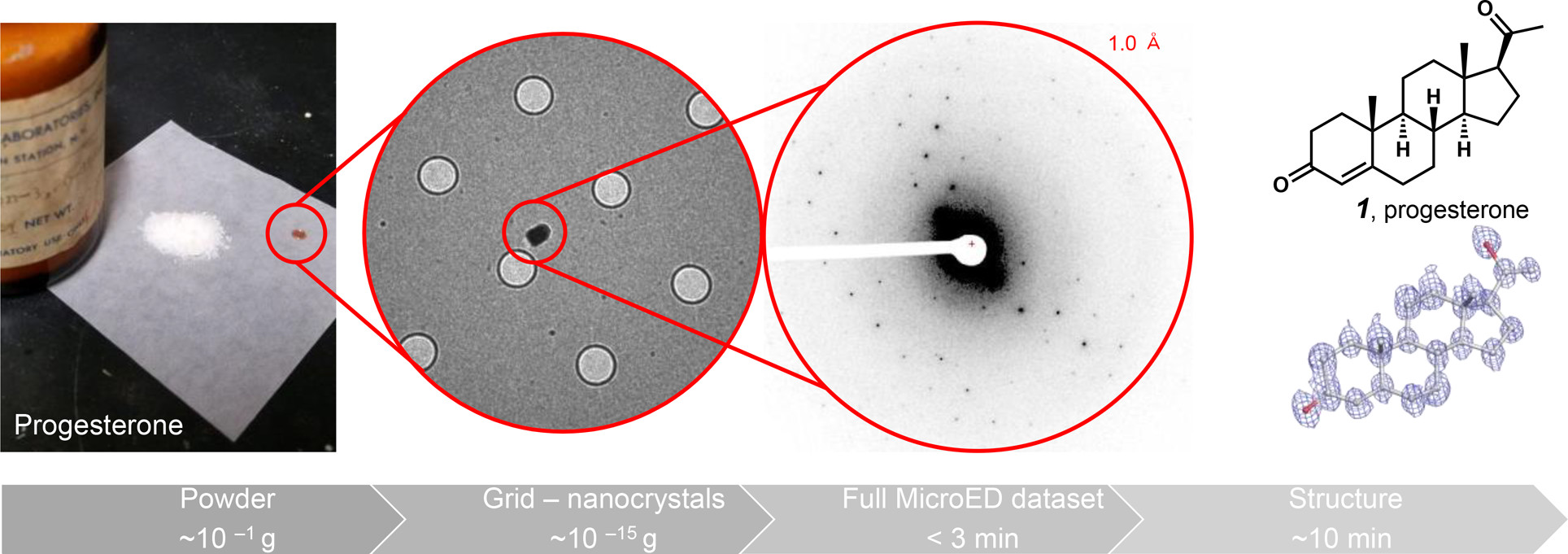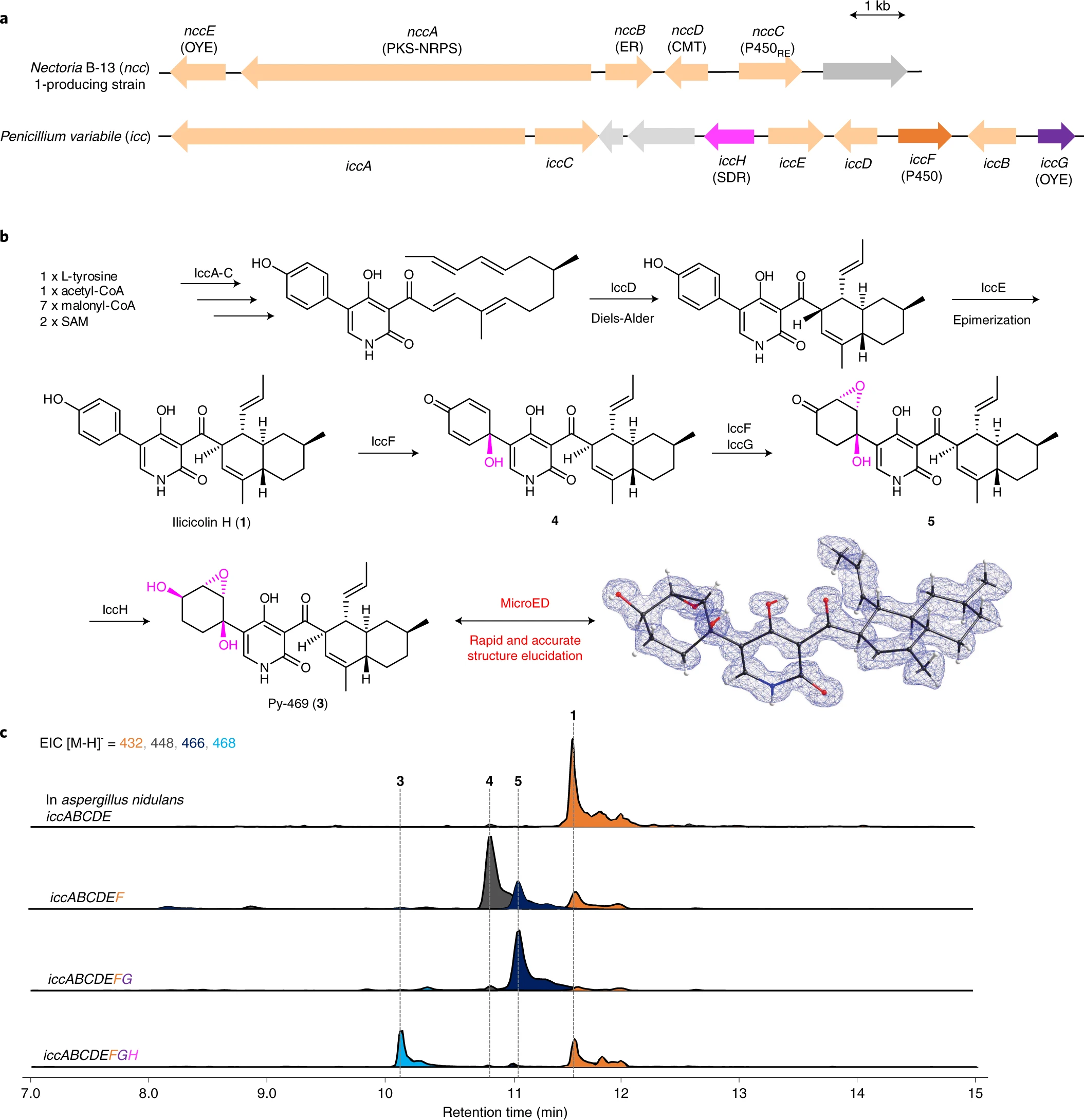MicroED for Structural Analysis Service
- Electron beams, with their strong scattering power, can generate clear diffraction patterns from microcrystals using extremely low doses.
- Cryogenically fixed nanocrystals are continuously rotated to collect diffraction patterns from multiple angles.
- Using crystallographic methods (indexing, integration, scaling, and phase determination), a 3D electron density map is reconstructed.
- An atomic model is built based on the density, followed by structure refinement and functional interpretation.
MicroED for Structural Analysis Service is a three-dimensional structural determination service based on Microcrystal Electron Diffraction (MicroED) technology. It is specifically designed to resolve the atomic structures of nanocrystals and is particularly well-suited for systems that are difficult to crystallize, such as macromolecular fragments, small-molecule drugs, natural products, synthetic compounds, nanomaterials, and membrane protein microcrystals.
MicroED is an innovative structural biology technique that integrates cryo-electron microscopy with electron diffraction. It is optimized for determining the 3D atomic structures of nanocrystalline samples smaller than 1 μm. Treating microcrystals as single crystals, MicroED uses electron beams instead of X-rays to achieve high-resolution structure determination. Compared with traditional X-ray crystallography, MicroED requires significantly smaller crystals (as small as ~100 nm), drastically reduces sample quantity, and is gentler on radiation-sensitive specimens. Unlike Cryo-EM Single Particle Analysis (SPA), MicroED does not rely on 2D image reconstruction; instead, it directly reconstructs structures from diffraction intensities. MicroED bridges the gap between X-ray crystallography, Cryo-EM SPA, and NMR by accommodating a broader range of sample types and sizes, making it an essential and complementary tool in the field of structural determination.

Jones C G. et al. ACS Cent Sci. 2018.
Based on the MicroED platform, MtoZ Biolabs offers the MicroED for Structural Analysis Service acquiring electron diffraction data from microcrystals using a cryogenic transmission electron microscope (Cryo-TEM) and solves structures using single-crystal diffraction algorithms. This service enables clients to efficiently obtain high-resolution 3D structures of protein microcrystals, small-molecule drugs, natural products, and functional materials.
Technical Principles
The core of MicroED lies in utilizing a transmission electron microscope (TEM) as a diffraction platform for microcrystals:
Compared with X-rays, electrons have a higher scattering cross-section, making MicroED particularly suitable for minute quantities and radiation-sensitive samples. The cryogenic environment preserves both the native conformation and crystalline integrity of the specimen.
Analysis Workflow
The main workflow of the MicroED for Structural Analysis Service includes:
1. Sample Screening
Use negative staining, light microscopy, or electron microscopy to pre-screen crystal quality and size.
Apply microcrystals to carbon-coated copper grids and vitrify them by plunge-freezing.
2. Data Collection (Cryo-TEM with Rotation Stage)
Perform continuous-rotation data acquisition under liquid nitrogen using cryo-TEM.
Multiple microcrystals can be collected to enhance data completeness.
3. Data Processing and Structure Determination
Index diffraction patterns, integrate intensities, perform scaling and phase determination.
Use crystallographic software to build electron density maps and solve the structure.
Deliver refined structural models and resolution validation.
4. Data Delivery
Provide coordinate files in CIF/PDB format, diffraction images, electron density maps, and a full technical analysis report.
Applications
MicroED for Structural Analysis Service is applicable in the following research areas:
Small-Molecule Drug Structure Confirmation
Atomic-level structural determination of lead compounds, metabolites, and chiral molecules.
Natural Product Research
Resolution of scaffold architecture and absolute configuration for traditionally hard-to-crystallize natural extracts.
Protein Microcrystal Structure Determination
Ideal for membrane protein plate-like crystals and microcrystalline mutant variants.
Polymorph and Metastable Crystal Analysis
Suitable for physically unstable or short-lived crystal forms.
Materials Science and Nanochemistry
Structure determination of materials such as metal-organic frameworks (MOFs), 2D crystals, and other functional nanomaterials.
FAQ
Q. What’s the Difference Between MicroED and X-ray Single-Crystal Diffraction?
MicroED uses electrons instead of X-rays, allowing structural analysis of nanocrystals and solving the size limitations required by conventional X-ray diffraction (XRD). It is ideal for small quantities and submicron-sized crystals.
Q. Can I Analyze a Sample that’s not a Perfect Single Crystal?
Yes. As long as nanocrystalline or microcrystalline regions are present, diffraction signals may be obtained. MtoZ Biolabs offers pre-screening via TEM to assess whether a sample contains analyzable crystalline domains.
Q. What Deliverables are Included in the Results?
Standard deliverables include diffraction patterns, structure coordinate files (PDB/CIF), electron density maps, resolution evaluation reports, and experimental documentation. Optional services such as structure annotation, conformational analysis, or database submission are also available upon request.
Case Study
This study employed Microcrystal Electron Diffraction (MicroED) to determine the structures of natural products that are difficult to crystallize into large single crystals. The method was successfully applied to two classes of natural compounds: the newly discovered 2-pyridone derivative Py-469 and the classic cytotoxic natural product fischerin. MicroED not only resolved the precise atomic structure of Py-469 but also, for the first time, corrected the long-misassigned configuration of fischerin, confirming its unique arrangement of four quaternary stereocenters.

Kim L J. et al. Nat Chem Biol. 2021.
How to order?







